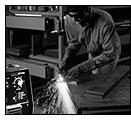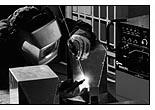- Преподавателю
- Иностранные языки
- Урок английского языка Из истории сварки
Урок английского языка Из истории сварки
| Раздел | Иностранные языки |
| Класс | - |
| Тип | Конспекты |
| Автор | Мурзина А.В. |
| Дата | 21.02.2016 |
| Формат | docx |
| Изображения | Есть |
Сабақ № 5-6 _____ Күні
№ урока Дата \ Date
Сабақтың тақырыбы
Тема урока
The theme of the lesson Виды сварки
Сабақтың мақсаты
Цель урока
The aims of the lesson
-
Білімділік
Образовательная ориентация на формирование развития аудитивных навыков и умений; развитие неподготовленной монологической речи на основе прочитанного текста, понимание высказываний учителя и собеседника в различных ситуациях общения, в том числе при наличии незнакомых языковых средств; понимание учебных текстов
-
Дамытушылық
Развивающая ввести новую лексику - терминологию сварочного дела; развивать монологическую и диалогическую речь; формировать умение выделать главное / частное
-
Тәрбиелік
Воспитательная повысить мотивацию к изучению английского языка
Сабақтың түрі
Тип урока ознакомление с новым материалом
The type of the lesson
Жұмысты ұйымдастыру
Форма учебной работы фронтальная
Study form
Өзiндiк жұмыстың түрлерi работа с учебником, выполнение практических
Виды самостоятельной работы заданий по тексту
Types of an independent work
Аралық пәндiк және пәндiк байланыс История Терминология, Спецтехнология, ТБ,
Межпредметная и внутрипредметная связь Ручная дуговая сварка, Электротехника,
Inter subject and intra subject intercommunication Газовая сварка и резка металлов
Өндірістік тәлім-тәрбиемен байланыс История развития сварки. Значение и применение
Связь с производственным обучением сварки в различных отраслях экономики.
Intercommunication with occupational training
Жабдық Раздаточный материал (Текст для чтения,
Оборудование практические задания по тексту, словарь терминов)
Equipment доска, мел
The steps of the lesson
1. The first step
- greeting
- introduction aims of the lesson
journeyman (person)
наемный квалифицированный рабочий
apprentice
ученик
plate working
обработка листового металла
blueprint
1) делать светокопию, копировать чертеж 2)делать разметку
brazing
пайка твердым припоем (из меди и цинка)
GTA (gas tungsten arc) welding
сварка неплавящимся электродом
TIG (ungsten inert gas welding)
дуговая сварка вольфрамовым электродом в среде инертного газа
SMAW (shielded metal arc welding)
дуговая сварка покрытым металлическим
электродом
SAW (submerged arc welding)
(дуговая) сварка под флюсом
resistance welding
(контактная) сварка сопротивлением
flux core
флюсовая сердцевина ( порошковой проволоки )
metal core
металлический сердечник
shift work
(по)сменная работа, работа по сменам
- New words
2. The central part of the lesson
Working with the text.
Reading the text. Ex. I
What is welding and what do welders do?
Welding is the most economical and efficient way to join metals permanently. It is the only way of joining two or more pieces of metal to make them act as a single piece. Welding is vital to our economy. It is often said that over 50% of the gross national product of the U.S.A. is related to welding in one way or another. Welding ranks high among industrial processes and involves more sciences and variables than those involved in any other industrial process. There are many ways to make a weld and many different kinds of welds. Some processes cause sparks and others do not even require extra heat. Welding can be done anywhere…outdoors or indoors, underwater and in outer space.
Nearly everything we use in our daily life is welded or made by equipment that is welded. Welders help build metal products from coffeepots to skyscrapers. They help build space vehicles and millions of other products ranging from oil drilling rigs to automobiles. In construction, welders are virtually rebuilding the world, extending subways, building bridges, and helping to improve the environment by building pollution control devices. The use of welding is practically unlimited. There is no lack of variety of the type of work that is done. 
Welders are employed in many industry groups. Machinery manufacturers are responsible for agricultural, construction, and mining machinery. They are also involved in bulldozers, cranes, material handling equipment, food-processing machinery, papermaking and printing equipment, textiles, and office machinery.
The fabricated metals products compiles another group including manufacturers of pressure vessels, heat exchangers, tanks, sheet metal, prefabricated metal buildings and architectural and ornamental work. Transportation is divided into two major groups: manufacturers of transportation equipment except motor vehicles; and motor vehicles and equipment. The first includes shipbuilding, aircraft, spacecraft, and railroads.
The second includes automobiles, trucks, buses, trailers, and associated equipment.
A small group of welders belongs to the group of repair services. This includes maintenance and repair on automobiles or refers to the welding performed on industrial and electrical machinery to repair worn parts.
The mining, oil extraction, and gas extraction industries form yet another group. A large portion of the work involves drilling and extracting oil and gas or mining of ores, stone, sand and gravel.
Welders are also employed in the primary metals industries to include steel mills, iron and steel foundries, smelting and refining plants. Much of this work is maintenance and repair of facilities and equipment. Another group is the electrical and electronic equipment companies. Welding done by this group runs from work on electric generators, battery chargers, to
household appliances.
Public administration employs welders to perform maintenance welding that is done on utilities, bridges, government armories and bases, etc. Yet another group involves wholesale and retail establishments. These would include auto and agricultural equipment dealerships, metal service centers, and scrap yards.
Probably the smallest group of welders, but perhaps those with the biggest impact on the public are the artist and sculptors. The St. Louis Arch is possibly one of the best
known. But there are many other fountains and sculptures in cities and neighborhoods around the world.
Ex.II.Find the English equivalents for the following words and word combinations:
Валовой национальный продукт, на открытом воздухе, в помещении, космический корабль, горное оборудование.
Ex.III.True or false?
1. Welding is an important process employed by modern industry.
2. All welding processes are similar.
3. All welding processes require work pieces to be heated.
4. The smallest group of welders belongs to the group of repair services.
5. Welding is the only way to join metals.
3. The end of the lesson
Summing up of the lesson.
Marks of the lesson.
Home task - Лексика по теме урока, терминология сварочного дела.


